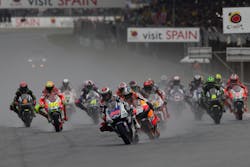Sepang MotoGP debrief with Masao Azuma
This year’s Malaysian Grand Prix was affected by an intense tropical downpour that resulted in the race being red-flagged after thirteen laps. Repsol’s Honda Dani Pedrosa claimed victory at a soaked Sepang ahead Yamaha Factory Racing’s Jorge Lorenzo in second place and teammate Casey Stoner who finished third.
Track conditions varied greatly over the weekend, with riders experiencing from fully wet to fully dry. This wide range of weather resulted in every specification of tyre brought to Sepang being used as riders tried to adapt to the changing track conditions. The rain that fell before and during the MotoGP race made wet tyres a necessity and all riders opted for the hard compound front wet tyre, while rear tyre choice was equally divided across the grid with ten riders each selecting the soft and hard compound wet tyre.
Q&A with Masao Azuma – Chief Engineer, Bridgestone Motorsport Tyre Development Department
Rear tyre choice for the race was equally split between the soft and hard compound wet tyre. In the conditions we saw on Sunday, which rear tyre was the better choice?
“Just like in slick tyres, softer rubber compounds in wet tyres give better warm-up performance and grip compared to hard compounds which grant better durability and cornering stability. With the weather being so variable in Malaysia, it was difficult to tell which wet rear tyre would work best for the race, though due to the warm temperatures at Sepang which dry out the track quickly and make warm-up performance not as critical, our main wet tyre for this race was the hard compound option.
“The heavier rain just before the red flag increased the amount of standing water on track to the point where regardless of which compound a rider selected, grip levels were very low. Those riders that selected the soft compound perhaps thought that the track would stay consistently wet, as the soft option should be better in such conditions. On the other hand, had the rain stopped completely, those riders that selected the harder rear compound would have had the benefit of more consistent grip towards the end of the race as the track dried out.”
Many riders remarked that the track in dry conditions felt very different this weekend compared to the pre-season tests held at Sepang earlier in the year. Does your data agree with this observation?
“Yes, the reason for this is unclear but the grip levels of the circuit this weekend weren’t as high as experienced earlier in the year. During winter testing grip levels were better and this was reflected in quicker lap times and a general improvement in the level of performance. In February, lap times in the 1’59 bracket were recorded, and the best lap time last weekend was a 2’00.3. Also, more riders experienced chatter this weekend than during winter testing, even at the second test when we introduced the new specification front tyre, so the condition of the circuit was obviously very different compared to February.
“Though we don’t know the exact reason why this situation occurs, this tendency for the Sepang circuit to have less grip during the October race weekend compared to winter testing happens almost every year. The track temperatures in winter testing tend to be higher and there is less rainfall at this time, so this could be a contributing factor to the better track condition at this time.”
